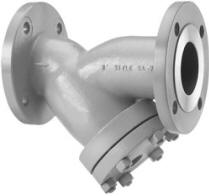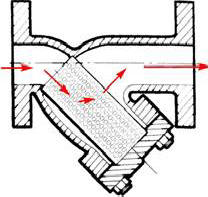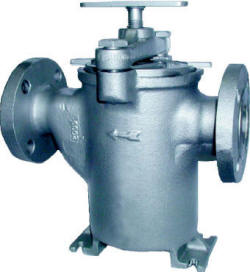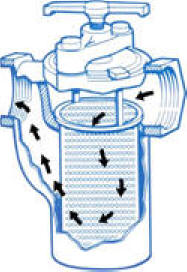Y Strainer vs. Basket Strainer Design
Differences between Y and Basket Style Strainers
Both Y and basket style strainers require isolating the strainers inlet and outlet to physically clean the straining element (thus interrupting the process flow), however there are significant functional differences that, depending upon specific application characteristics, will determine whether a Y or basket style strainer is best style for your application.

 Y Strainers
Y Strainers
Although Y strainers are applied to liquid applications regularly, they were
initially designed for steam, air and other inert gases to protect downstream
equipment from a “particulate upset condition”; what we mean by that phrase is
that normally particles are not expected, however as piping systems age bits of
pipe scale, gaskets and other materials can become entrained in the process
flow. Y strainers have a “blow down” port for this reason, bits of pipe
scale can be “flushed” from the screen chamber by attaching a valve to this port
and when opened to atmospheric pressure the material within the screen chamber
is “flushed” through the valve.
The key takeaway about the design of a Y strainer is that it is designed to
protect downstream equipment from material that isn’t continuously present in
the process flow. Another way to describe this is that the percentage of
particles to be removed from the process fluid should be relatively low if you
are going to use a Y strainer.
There isn’t anything “wrong” about using a Y strainer for liquid applications;
in-fact Y strainers have some advantages:
•
•
Perhaps the most significant downside of a Y strainer when compared to a basket
strainer is the “open area ratio”. The open area ratio (OAR) is the ratio
of the cross-sectional area of the inlet/outlet port compared to the open area
of the element.
A straining element is either perforated or having a perforated substrate with a
mesh lining for finer retention. Generally speaking, the finer the
retention, the less open area the straining element has; why is this important?
The percentage of open area combined with the flow coefficient (CV)
of the strainer itself (design dependent) will determine the pressure drop
across the strainer for a given flow rate. Generally speaking the higher
the CV, the less of a pressure drop there will be across the strainer
body; the open area of the straining element will determine how much more the
initial differential pressure will increase.
Since Y strainers were not designed to continuously remove particulate, their
design (strainer element chamber and element dimensions) are only designed to
provide straining ratios of 1:1, 2:1 and perhaps in some cases 3:1, meaning at
best the element has 3 times open area compared to the diameter of the
inlet/outlet connection.

 Basket Style Strainers
Basket Style Strainers
The phrase “Simplex Strainer” has become ubiquitous for basket strainers even
though Y, Tee and other variations are also “simplex” in nature, so for clarity
we’ll refer to them as basket strainers.
Getting back to the OAR aspect, the real differentiator, basket strainers
typically have an OAR of 6:1 and sometimes as high as 8:1; significantly more
than a Y strainer. This is why basket strainers are used for applications
that have a continuous particle load. Thus an application such as
reclaimed cooling tower water, where there’s an expectation of particulates that
need to be removed all the time, is a better fit for a basket strainer than a Y
strainer.
The difference in straining ratios is approximately the difference in frequency
that the straining element will need to be cleaned, thus you would expect to
clean a Y strainer screen that has a 2:1 OAR about 3 times as often as you would
clean a basket strainer having a 6:1 OAR.
In summary, most liquid filtration applications that are either batch processes
or where it’s acceptable to interrupt the flow to clean the straining element
will be best suited for basket strainers due to their higher OAR and physically
larger holding capacity. Y strainer applications are typically for inert
gasses and for liquid applications where the particle loading is very low or
only expected during an upset condition.



